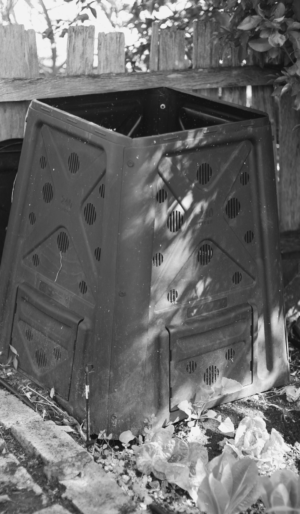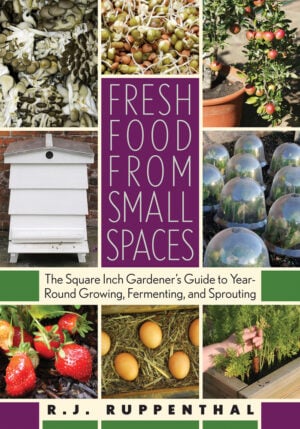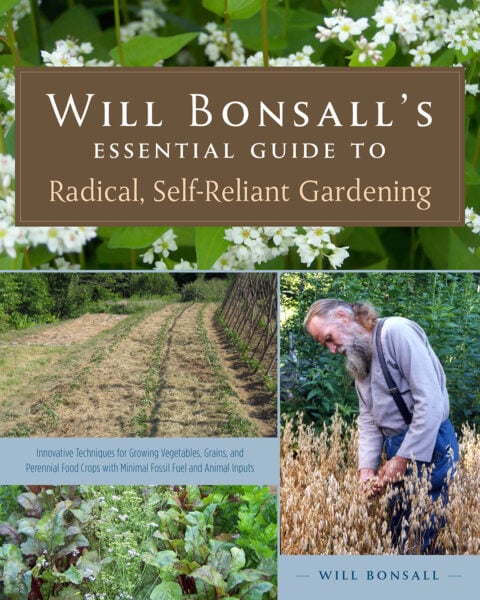Food for Your Garden: Starting a Traditional Compost Pile in Your Yard

What can we do to reduce our waste? Use less, recycle and reuse packaging materials, and compost your organic waste. And if you’re a gardener, there’s no reason to throw away this beneficial (and cheap!) source of nourishment for your soil.
Compost is the key to a flourishing garden. Turn your kitchen scraps and yard waste into food your garden will love.
The following is an excerpt from Fresh Food from Small Spaces by R. J. Ruppenthal. It has been adapted for the web.
How to Start A Traditional Compost Pile
If you have enough space to start a compost pile in your yard, make sure your local city and county ordinances permit it. Some of them have restrictions because open piles can attract rodents and create odors. Assuming that your area allows open-air composting, consider whether you can fit three piles in your yard: one for new compost, one for aging compost, and one for the finished stuff that goes back on your plants. If you just have room for one, that is fine, but in order for your pile to fully break down, you will need to stop adding new material at some point and let it decompose.
Some compost piles are hot, while others never get very warm, and this is a function of the biological activity in the pile while the organisms do their thing. Getting your pile to heat up naturally depends on a long list of factors, including pile size, materials, layering, moisture, external heat, and other variables. But even if it does not heat up much, sooner or later the stuff will break down and you’ll have some good dirt to use on your plants.
Cold compost is perfectly acceptable stuff; it just takes a bit longer to make. Some gardening purists hold that the nutritional content of hot-cooked compost is far superior, but if you are using it as more of a soil amendment than a fertilizer, then this should not matter much. If you want to follow the pure wisdom, then the minimum size for a hot pile is about 4′ x 4′, which will allow enough internal space to create the proper conditions for this biological activity to take place.93 In lieu of this, any untidy heap will break down at its own pace.

A compost bin can fit almost anywhere, either over garden soil or on a patio. ©iStockphoto.com/davidf
What should you put in your compost pile? Will it stink? Do you have to turn it regularly? The answers are: anything organic, a bit, and not really.
Dead leaves, lawn clippings, food scraps (except meat or fat), newspaper, cardboard, and manure are all organic matter and will break down in your compost pile. Ideally, you want to add a diversity of ingredients.
The pile will break down faster if you add both “browns” (dry ingredients such as dead leaves, newspaper, and cardboard) and “greens” (wet stuff such as food scraps, lawn clippings, and fresh manure).
“Greens” contain plenty of nitrogen while “browns” have more carbon, and your pile needs both. Conventional wisdom holds that the proper ratio is 2 parts “browns” to 1 part “greens,” but you can vary this ratio somewhat. Just remember that a pile of 100 percent leaves takes a lot longer to break down, and 100 percent food scraps may turn into a very wet and slimy mess long before it breaks down. Also, the more diverse sources of waste you add, the better its nutritional output will be for your soil.
Your new pile will stink a bit at first, but if you have never composted before, then you will be pleasantly surprised. It’s not as smelly as you would think. In its early stages, you can cover the compost pile with burlap, a tarp, or a layer of “brown” ingredients such as leaves or cardboard, which will help seal in the moisture and limit any odors. As the compost ages, it begins to smell more earthy, a fragrance that some actually enjoy.
Your compost is finished when you can no longer recognize the individual materials that went into it.
Aerating the pile is optional, but it may speed up the process by delivering oxygen where it’s needed. Use a pitchfork to turn the pile and make sure that both air and moisture are reaching each part. You can do this weekly or less often. And, if you do not want to turn the pile, then it will aerate naturally with time as the layers break down and settle.
Recommended Reads
Recent Articles
“An immediate halt to chemical fertilizing and returning to the use of compost instead would turn degeneration into regeneration.”
Read MoreIf you’re not familiar with silvopasture, you should be. The integrated system offers both the promise of land regeneration and economic livelihood.
Read MoreAs the weather heats up, now’s the perfect time to grow and pick cucumbers! With these easy tips and tricks, you’ll be prepared to successfully harvest and store the cucumbers you grow until they’re ready to eat. Unless otherwise noted, all photographs copyright © 2017 by Andrew Mefferd. The following is an excerpt from The Greenhouse and…
Read MoreSome of the world’s most productive and resilient soils contain significant quantities of “natural” biochar. Author Kelpie Wilson challenges us to “change our perspective from ‘too much carbon in the air’ to ‘not enough carbon in the soil.’ We are good at being miners and exploiting resources, so let’s mine the air and stash the…
Read MoreAside from the sheer pleasure of telling your friends, straight-faced, that you maintain your garden using something called a “chicken tractor,” there are a slew of other benefits to working the land with a few of your animal friends. Getting rid of pests without chemicals, for one; letting them do the work of weeding and…
Read More








